November Special
Climate Change: COP 26

At the COP 26 UN Climate Change Conference, hosted by the UK in partnership with Italy, during October-November 2021, at Glasgow, UK, the participating countries vowed to work with partners to take further action on protecting and restoring forests and critical ecosystems and to facilitate the transition towards sustainable, resilient, and nature positive agriculture.
Discussions were held on how to adapt to protect communities and natural habitats. Owing to the mostly negative impact of climate change on agriculture, the countries indicated the need to work together to enable and encourage countries affected by climate change to protect and restore ecosystems, build defences, put warning systems in place, and make infrastructure and agriculture more resilient to avoid the loss of homes, livelihoods, and lives. The international community reiterated that it must unite and support people who are most vulnerable to the impacts of the changing climate. We need more action to avert, minimise, and address the loss and damage that is already occurring from climate change. Plans and more finance need to be put in place to improve early warning systems, flood defences, and build resilient infrastructure and agriculture, to avoid further loss of life, livelihoods, and natural habitats.
The final decisions taken, however, do not seem to contain any action directly on sustainable livelihoods and agriculture. There are 11 references to nature themes in total across the COP and CMA decisions, including further action on ocean and land. This builds on the language used at COP 25 and aims to increase global awareness of the critical role of protecting, conserving, and restoring nature and ecosystems for climate change adaptation and mitigation, including forests and biodiversity. Agriculture gets mentioned sparingly in a few pledges; for example, The Global Methane Pledge (https://www.globalmethane.org/), AIM for Climate Initiative (AIM4C) (https://www.aimforclimate.org/), Fast Tracking Climate Solutions from CGIAR Genebank Collections, ClimateShot (https://www.climateshot.earth/), Koronivia Joint Work on Agriculture (https://www.fao.org/koronivia/resources/en/), etc.
For more detail on discussions and decisions that directly impact agriculture and related areas, see the following:
- Aspirations: https://2nsbq1gn1rl23zol93eyrccj-wpengine.netdna-ssl.com/wp-content/uploads/2021/07/COP26-Explained.pdf
- Results: https://ukcop26.org/wp-content/uploads/2021/11/COP26-Negotiations-Explained.pdf
- Related article: Abstract at https://www.nature.com/articles/s43016-021-00225-9 which is read-only at https://www.nature.com/articles/s43016-021-00225-9.epdf?sharing_token=A4WNWFR1WQX0aJz86VEYtNRgN0jAjWel9jnR3ZoTv0P_PEPIAmxUgB4MJaaTPg3pHBq0m44_l99rZf8mXoPIGFIMcOtPgGmv4MFkQRYyFIfH1MiU_ZMX22DwFCb8ouKiKEZzyKcroiQQta9oASkXB7Y8z4K6WelSlXjwim5ASRotL8mCSFmZh8Gu2VF5xiur_CR2Wa2_VWoiwcerA93qs8hkhnMTWj-SUzoziKuRV4Q%3D&tracking_referrer=www.usnews.com
- COP wakes up to climate-friendly agriculture at https://www.icarda.org/media/blog/cop-wakes-climate-friendly-agriculture
Research Results
1. Crops are ‘imprinted’ by past droughts—which could help them prepare for future ones
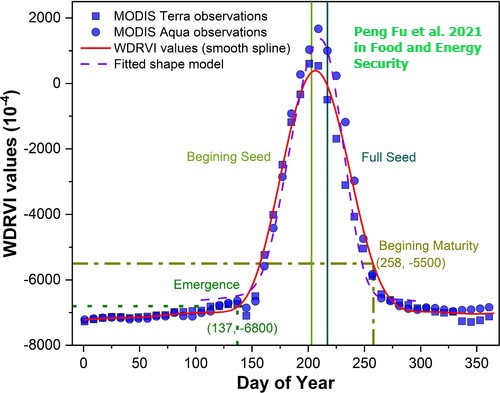
Based on 2 decades of research, Pen Fu and colleagues from the University of Illinois at Urbana-Champaign, USA, have found that crops that have been exposed to drought seem to ‘remember’ those stressful occasions and be better equipped to deal with them next time they roll around. This inbuilt resilience reduces yield loss, and it may be a clue to achieving greater food security under the vagaries of climate change. The soybean and maize crops, equipped with this natural resilience to late-season drought, were able to reduce their typical yield losses by up to 7%, compared to crops that didn’t receive the ‘priming’ benefit of early-season dryness. The current study’s landscape-scale findings could help us predict how crops will fare under rising climate change threats—information that’s critical for maintaining food security.
Intensifying climate changes in the coming decades are expected to deprive crops of the early-season, dry-weather prompt that has so far helped them adapt to summer droughts. On the bright side, having this landscape-level insight, now, into the climate responses of two staple American crops could help us prepare new interventions that will help them weather these coming changes and protect their yields. By identifying and enhancing those traits in plants, we could get closer to future crops that can cope with the intensifying pressures of heat and drought. Carrying out similar studies in other areas that are expected to be seriously affected by climate change (in terms of rainfall, droughts, etc.) can help to better understand this phenomenon and develop strategies to manage droughts better.
Access the full paper at https://onlinelibrary.wiley.com/doi/10.1002/fes3.332
2. Scientists solve a 50-year-old mystery behind plant growth
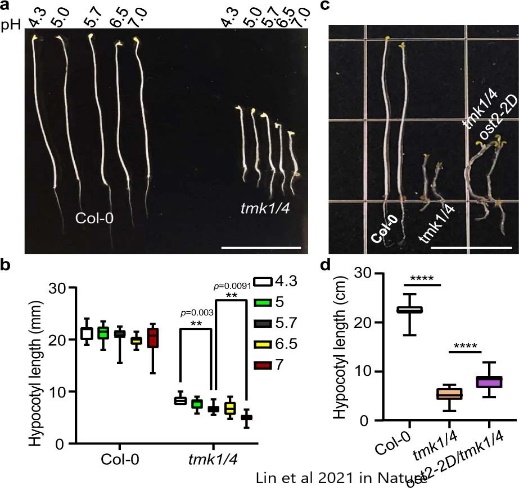
Plant cells are encased in shell-like cell walls, whose primary layer has three major components: cellulose, hemicellulose, and pectin. These components define the shape of plant cells, resulting sometimes in surprising formations like the puzzle-piece-shaped leaf epidermis cells. Researchers have wondered for the last several decades about how, with everything locked so tightly by the cell walls, movement and growth are possible? A team of researchers, led by Wenwei Lin at UC Riverside, USA, has demonstrated for the first time one way that a small molecule turns a single cell into something as large as a tree.
The latter mechanism also lowers the pH of the cell and facilitates growth. The genetic, biochemical, and molecular evidence from the study demonstrates that transmembrane kinase (TMK) auxin-signalling proteins directly phosphorylate plasma membrane H+-ATPase, a proton pump, which plays a central role in physiological functions, including acidification and cell expansion. These findings reveal a crucial connection between auxin and plasma membrane H+-ATPase activation in regulating apoplastic, i.e., the space outside the plasma membrane within which material can disperse freely, pH changes, and cell expansion through TMK-based cell surface auxin signalling. Lowering the pH in a cell wall can allow water outside of a cell to move in, fuelling turgor pressure and expansion. In addition, auxin can turn on gene expression in the nucleus of the plant’s cells, which in turn increases the amount of expansion and other growth-regulating factors in the cell.
For more, see https://phys.org/news/2021-11-scientists-year-old-mystery-growth.html
Access the full paper at https://www.nature.com/articles/s41586-021-03976-4
3. How do plants act fast to fight off infections?
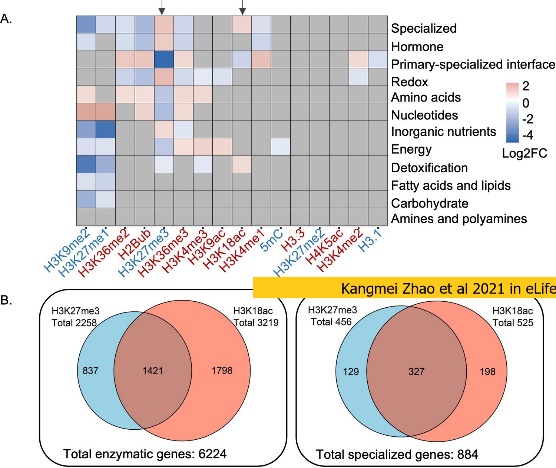
Understanding how plants respond to stressful environments is critical for developing strategies to protect important food and biofuel crops from a changing climate. New work led by Carnegie Institution for Science’s Kangmei Zhao and Sue Rhee reveals a new mechanism by which plants can rapidly activate defences against bacterial infections. Such an understanding could inspire efforts to improve crop yields and combat global hunger.
Since temporal dynamics of gene expression underpin responses to internal and environmental stimuli, the researchers set out to elucidate how a plant cell can rapidly fire up the production line and respond to external conditions or threats at the right time. Camalexin is one of the most potent defence compounds in Arabidopsis thaliana, which can be rapidly induced by bacterial and fungal infections. However, camalexin and other defence compounds are often very expensive (in terms of energy) and toxic for the plants to make continuously, and they need to be made rapidly to ward off any infection as it sets in. The present study indicates that two epigenetic modifications with opposite effects on gene expression, trimethylation of lysine 27 of histone 3 (H3K27me3) (repression) and acetylation of lysine 18 of histone 3 (H3K18ac) (activation), combine to form a previously uncharacterized type of bivalent chromatin. It appears that both modifications are required to determine the timing of gene expression and metabolite accumulation at an early stage of the stress response. Thus, the researchers now have a new handle on a molecular mechanism that enables this precise timing of camalexin production. “This finding could inform strategies for fighting climate change and global hunger, or even the synthesis of plant-derived medicines,” says Zhao.
For more, see https://www.sciencedaily.com/releases/2021/10/211027085343.htm
Access the full paper at https://elifesciences.org/articles/69508
4. New knowledge towards increasing carbon dioxide uptake in plants

Imagine being able to grow plants that could absorb even more CO2 from Earth’s atmosphere and thereby help solve the world’s climate problems. Humans have selected, bred, and optimized crop plants to increase food production. However, the primary process of food production, i.e., photosynthesis, has hardly ever been focused on any selection process. With new technologies at hand, scientists around the world are now working to understand the internal processes of plants that drive photosynthesis. Omar Sandoval-Ibáñez and colleagues from the University of Copenhagen, Denmark, have discovered that a group of proteins in plant leaf cells, called CURT1, plays a much more important role in photosynthesis than once thought.
Researchers used combined two- and three-dimensional electron microscopy, spectroscopy, and biochemical methods to determine the role of CURT1 proteins in the formation of etioplast cubic membranes and their transformation to photosynthetically active chloroplast thylakoids. CURT1 proteins were previously recognized as significant contributors to thylakoid membrane folding. Now it is found that CURT1 proteins are integral proteins of etioplast membranes, and they act as factors modulating etioplast prolamellar bodies and prothylakoid nanomorphology. They are also required for concerted thylakoid maturation under de-etiolation. “This is an important step on the way to understanding all of the components that control photosynthesis. The question is whether we can use this new knowledge to improve the CURT1 protein complex in plants in general, to optimize photosynthesis,” says Mathias Pribil, the study’s lead author. “Much of our research revolves around making photosynthesis more efficient so that plants can absorb more CO2. Just as we have selected and bred the best crops throughout the history of agriculture, it is now about helping nature become the best possible CO2 absorber,” says Mathias Pribil.
Access the abstract at https://www.pnas.org/content/118/42/e2113934118
5. Research reveals cultivation of plants with genes from one parent
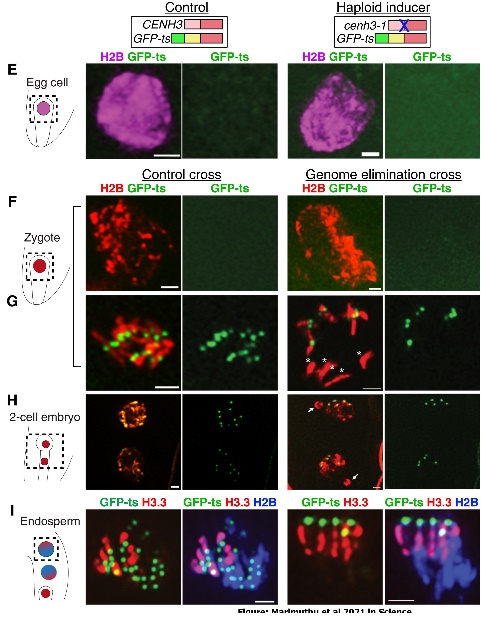
Producing maternal haploids via a male inducer can greatly help hybrid breeding programmes in many crops, via distant hybridization. However, the mechanism underlying haploid formation remains unclear. Wide crosses result in postzygotic elimination of one parental chromosome set, but the mechanisms that result in such differential fate are poorly understood. According to a study by plant biologists led by Mohan Marimuthu at the University of California, Davis, scientists are a step closer to breeding plants with genes from only one parent. Plants, like other sexual organisms, inherit a matching set of chromosomes from each parent. In 2010, Chan and postdoctoral fellow Ravi Maruthachalam serendipitously discovered a way to eliminate the genetic contribution from one parent while breeding the lab plant Arabidopsis. When they tried to cross wild type Arabidopsis with plants with modified CENH3, they obtained plants with half the normal number of chromosomes.
The part of the genome from one parent plant had been eliminated to create a haploid plant. Recently, other labs have created plants with one set of chromosomes by manipulating CENH3, but it’s not clear how the results are related. Marimuthu and his colleagues found that when CENH3 protein is altered, it is removed from the DNA in the egg before fertilization, weakening the centromere. The analysis of CENH3 variant–mediated haploid induction in Arabidopsis thaliana demonstrates its dependency on selective destabilization of HI-CENH3 variants during fertilization. The resulting differences in CENH3 stability provide insight into mechanisms that maintain the epigenetic memory of centromeric chromatin. Together, these findings provide a firm basis for further mechanistic insights and a framework for evaluating mechanisms of genome elimination in biotechnology and during distant hybridization of different crop species.
For more, see https://www.aninews.in/news/science/research-reveals-cultivation-of-plants-with-genes-from-one-parent20211122170308/
Access the full paper at https://www.science.org/doi/10.1126/sciadv.abk1151
Potential Crops/Technologies/Concepts
1. Diploid potatoes have a role to play in the future, while ongoing work aims to bring back Solanum jamesii, aka the Four Corners potato
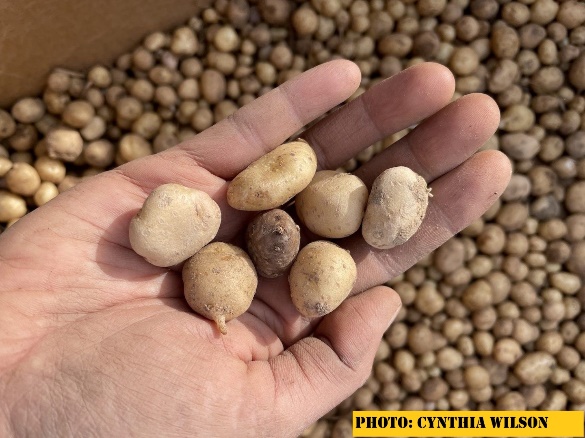
The words diploids and true potato seeds have been popping up a lot recently in the potato research and breeding worlds. Just a few years ago, growing diploid potato in farmer’s fields seemed like something far off in the future, but now more potato breeders are trying to hasten the process. As diploid potatoes are self-incompatible, self-compatibility genes need to be introduced into selected parents. Self-compatibility is important to make the plants as homozygous as possible to develop inbred lines. “The trick now is to introduce these self-compatibility genes into the parents that we want to use for diploid potato breeding. Self-compatibility is important because remember that we want to make the plants as homozygous as possible,” explains Josh Parsons, a scientist with FritoLay. Other issues need to be resolved, and with concerted collaborative efforts of potato breeders, it should be possible in a few years or decades.
The Four Corners potato, known by botanists as Solanum jamesii, is unlike any potato that is generally used and known all over the world. While the case for the Four Corners potato’s domestication remains uncertain, several indigenous people familiar with the potato are concerned about the breeding research, especially given that much of the USDA’s work has happened without the formal participation or permission of any of the tribes connected to the potato. S. jamesii has sustained indigenous people in the American Southwest for 11,000 years. USDA is now studying its 8-year shelf life, and its resistance to disease, heat, and drought. The future of this remarkable little potato remains unwritten, but it appears to hold tremendous promise; this tiny potato is the beginning of something greater than a valuable new crop.
For more, see https://seedworld.com/diploid-potatoes-coming-into-play-in-the-future/ and https://thecounter.org/four-corners-potato-species-indigenous-crop-navajo-nation-usda-southwest-future/
Access a related paper at https://link.springer.com/article/10.1007/s11540-021-09501-4 And https://bsapubs.onlinelibrary.wiley.com/doi/epdf/10.1002/ajb2.1737
2. Scientists develop a high-yielding, bio-fortified, drought-tolerant desi chickpea variety
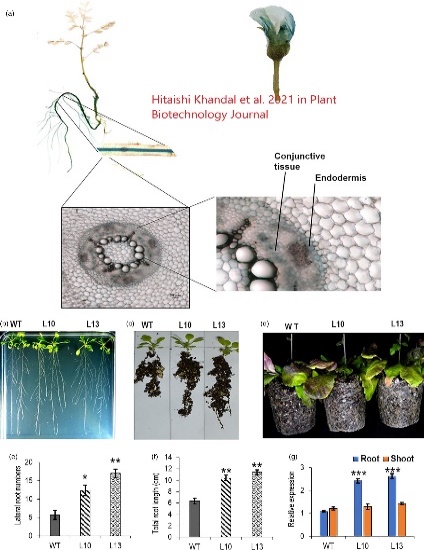
Recently, a group of scientists from the National Institute of Plant Genome Research, in India, successfully developed a new, high-yielding, transgenic desi chickpea variety, using the chickpea cytokinin oxidase/dehydrogenase gene expressed under the chickpea WRKY31 gene promoter. This promoter was selected to modulate the cytokinin level in roots and to investigate the effect of cytokinin depletion in root growth and architecture, and subsequently, on the yield and productivity. A robust increase in root network was recorded, without any apparent negative effect on the shoot. The transgenic chickpea lines exhibited higher seed yield up to 25%, without a reduction in protein content. The seeds contained higher levels of zinc, iron, potassium, and copper.
This provides interesting information (for crop scientists working on chickpea and other indeterminate legume crops) on the potential of cytokinin level manipulation in increasing lateral root number and root biomass for agronomic trait improvement. The expression of an Arabidopsis CKX6 ortholog of chickpea in the root endodermal cells of chickpea produced a robust increase in root network, and it improved tolerance to long-term drought, without any apparent negative effect on the shoot. Chickpea is mostly grown in semi-arid regions during the postrainy season, and it faces terminal drought during flowering, causing considerable yield loss. Enhancing the root network by local manipulation of cytokinin level might be an effective approach, along with conventional breeding, to alleviate yield loss in chickpea and other indeterminate legume crops.
For more, see https://globalplantcouncil.org/scientists-developed-a-high-yielding-bio-fortified-drought-tolerant-desi-chickpea-variety/
Access the full paper at https://onlinelibrary.wiley.com/doi/full/10.1111/pbi.13378
3. Can CRISPR keep the beer flowing and keep bread and cereals coming in a warming future?
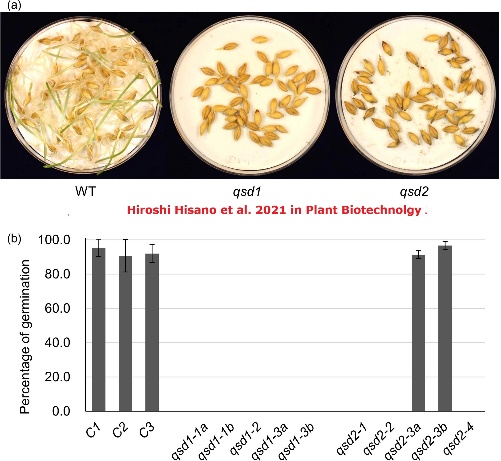
Barley, a staple crop around the world, is grown for animal feed, breads, and cereals, and, most crucially of all, as malt for making beer and whiskey. Premature sprouting makes barley less useful and less valuable on the market, damaging farmers’ incomes. Climate change appears to exacerbate the problem, as warmth and unexpected rain can kick off the early sprout. Thus, a warming world is posing problems for barley, an essential ingredient for breads, cereals, and beer. Researchers at Japan’s Okayama University, led by Hiroshi Hisano, are turning to CRISPR to create better, more resilient varieties of barley and to create barley that resists pre-harvest sprouting.
Researchers used Cas9-induced targeted mutagenesis to create single and double mutants in QTL FOR SEED DORMANCY 1 (Qsd1) and Qsd2 in the same genetic background. Tests demonstrated that normal early grain germination requires both Qsd1 and Qsd2 function. All of the mutant varieties sprouted when exposed to cold temperatures, which the researchers say is a sign that their dormancy genes were merely dormant, not turned off, which is important because we do need the barley to sprout eventually for making malt. Elucidation of mutant allele interactions, such as those shown in this study, are important for fine-tuning traits that will lead to the design of grain dormancy through combinations of mutant alleles. Thus, these mutants will provide the necessary germplasm to study grain dormancy and germination in barley.
For more, see https://www.freethink.com/environment/crispr-barley
Access the full paper at https://onlinelibrary.wiley.com/doi/10.1111/pbi.13692
4. Gliricidia intercropping in Zambia shows promising results
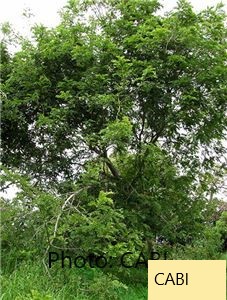
The species Gliricidia sepium is a deciduous tree, cultivated and used for a variety of purposes in tropical regions. The benefits of Gliricidia for improving crop nutrition are generally known. Among other things, Gliricidia intercropping has proved to significantly reduce the tannin and phytic contents in soybean, groundnut, and maize grains. One of the treatments tested has included Gliricidia intercropping with maize, soybean, and groundnuts, with sole crops as control trials.
In Zambia, it is mainly used for timber, firewood, medicine, charcoal, living fences, and plantation shading. Additionally, both soil health and crop nutrition can be improved by the incorporation of the leguminous tree’s leaf biomass. In 2019, a joint research effort for demonstrating and documenting the effects of Gliricidia in different farming systems in Zambia was established.
Crop and soil samples from all sites have been collected and analyzed for—among other things—nutritional properties, mycotoxins, and microbial load. In general, the results show that the treatments with intercropping of Gliricidia provide higher ash, total carbohydrate, starch, amylose, and crude fibre contents than the controls consisting of sole maize. “So far, results from the project indicate that correlating available Gliricidia agroforestry technology with soil health can indeed improve crop nutrition,” says the Project Coordinator, Udaya Sekhar Nagothu from NIBIO. “This research should help show Zambian small-scale farmers how adopting Conservation Agriculture with agroforestry can contribute to healthier, more nutritious food crops.”
Check out related papers in a book at https://onlinelibrary.wiley.com/doi/book/10.1002/9781119525417
5. Ancient Australian plant promises to expand chemotherapy effectiveness
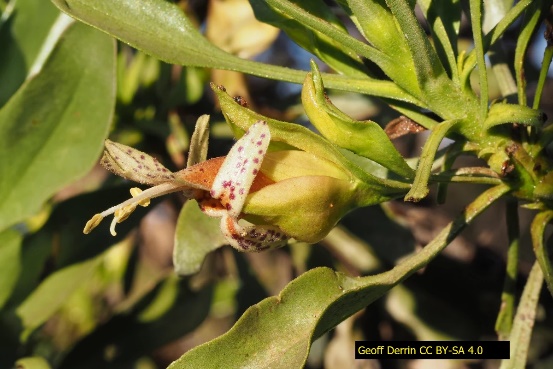
Researchers have isolated a compound from an Australian desert shrub with a long history of medicinal use by the indigenous peoples of Australia, which could help cancer patients better respond to chemotherapy. Researchers found a substance in a plant that appears to inhibit the cancer cells’ ability to defend themselves against chemotherapy, i.e., build resistance to chemotherapy. The plant is only found in Australia and has traditionally been used by the Aboriginal people. The species, Eremophila galeata, was specifically investigated, with a focus on hunting down any chemical compounds that could resensitize cancer cells resistant to a substance called SN-38, the active element in chemotherapy drugs designed to treat lung and colon cancers.
The plant indeed seemed to inhibit the ability of cancer cells to resist SN-38, so the researchers then set out to identify exactly which compounds were beneficial.
“Cancer cells resistant to SN-38 produce a large amount of a protein responsible for transporting the medicine out of the cancer cell again, a so-called efflux pump,” says project supervisor Dan Stærk, Project Coordinator and one of the corresponding authors. “This natural substance isolated from the Australian plant can inhibit this pump, which makes it difficult for the cancer cell to remove the medicine effectively.” While the particular kind of efflux pump protein inhibited by this plant compound is unique to cancer cells, the researchers are cautious in noting more work is needed to explore safety and efficacy in humans.
Access the full paper at https://www.mdpi.com/2218-273X/11/10/1534
6. Improved process to convert methane could turn a global warming liability into a profitable food security solution

Methane emitted from industrial sources across the United States is a major contributor to global climate change. An innovative process for converting methane, a potent greenhouse gas, into a food security solution has been stalled by economic uncertainty. It is feasible to reduce the cost that could make the approach profitable, using other methane sources and capable of meeting all global fishmeal demand. Although carbon dioxide is more abundant in the atmosphere, methane’s global warming potential is about 85 times as great over 20 years and at least 25 times as great a century after its release. Methanotrophic bacteria can transform this methane into useful protein-rich biomass, already approved for inclusion into animal feed.
To demonstrate the approach’s potential to meet demand profitably, researchers at Stanford, led by Craig Criddle, modelled scenarios in which methane is sourced from relatively large wastewater treatment plants, landfills, and oil and gas facilities, as well as natural gas purchased from the commercial natural gas grid. For example, in states such as Mississippi and Texas with low electricity prices, production costs came down by more than 20%, making it possible to produce fishmeal from methane for US$1,214 per tonne, or US$386 less per tonne than from conventional fishmeal production. If efficiencies like these could bring down the production cost for methanotroph-based fishmeal by 20%, the process could profitably supply total global demand for fishmeal with methane captured in the U.S. alone, according to the study.
Access the abstract at https://www.nature.com/articles/s41893-021-00796-2
News:
1. More than half of surveyed crop varieties are under threat of extinction, according to a study in India

While it is widely accepted that many crops and varieties are being lost at an alarming rate, empirical evidence is scanty as there remain large data gaps when it comes to knowing how many have been lost, and which crops and varieties are under imminent threat. Ehsan Dulloo and his colleagues used a rapid assessment technique to gather farmer knowledge about local agrobiodiversity, combined with a four-cell assessment method, to identify and calculate the level of threat for each crop and variety reported, including both farmer and improved varieties. Individual farmers listed the crops and varieties grown in their household, noted their uses, and indicated their spread and abundance, including information on varieties grown during the previous ten years which were no longer grown. More than 76% of extant landraces were reported as vulnerable, near threatened, threatened, or lost, while varieties of least concern were predominantly improved or released varieties. Results showed that landraces are still commonly grown in the study sites, especially in the central and western regions. With more than 50% of landraces considered threatened, conservation interventions are required to prevent large-scale genetic erosion. The authors propose a long-term monitoring framework for varietal diversity in India.
For more, see https://www.eurekalert.org/news-releases/934773
Access the full paper at https://www.mdpi.com/1424-2818/13/11/514/htm
2. Agriculture is often unfairly criticized as a carbon polluter, yet technological advances have dramatically reduced climate change impacts

Although more efforts were made to make agricultural practices “greener,” agriculture still receives a lot of negative judgment when it comes to its carbon emissions. (Note: one can survive without cars and planes but not without food; agriculture would remain as a high priority human activity). For decades, farmers and others working in agriculture have worked hard to implement practices to make their farms more sustainable and produce larger crops. It is probably time to flip our thinking as to how we can manage soils and farms with more climate positive practices and increase the amount of carbon that can be sequestered. Instead of looking at agriculture as an emitter, one should look at it as a sequester.
Luis Ribera, at Texas A&M University, says agriculture production has almost quadrupled while using 2% fewer inputs since the 1950s, which has resulted in reduced costs for consumers in the USA. Although the consumers in other countries may be paying relatively higher prices, concerted efforts can eventually bring costs down. New crop varieties have helped to make agriculture and farming more sustainable over the past decade. Ribera argues that new breeding technologies, such as gene editing, hold the promise to increase productivity and sustainability efforts even more. “Gene editing enables us to help crops adapt to changing environmental conditions much more quickly than a traditional breeding program, making crops more productive and increasing the yield, again to try to hold our agricultural footprint firm and steady and not need to bring in more land. These genetic technologies, in my mind, are game-changers,” she says.
For more, see https://seedworld.com/flipping-the-thinking-on-going-green-in-ag/
3. These ecosystems could determine our future climate
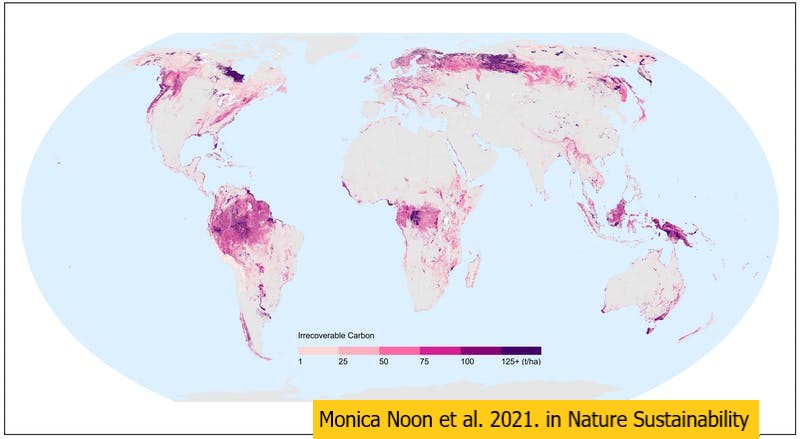
Avoiding catastrophic climate change requires a rapid reduction in CO2 emissions and improved ecosystem stewardship at the global level. Though the timeframe of carbon recovery for ecosystems—such as peatlands, mangroves, and old-growth forests—is shorter (centuries), this timeframe still exceeds the time humans have to avoid the catastrophic impacts of global warming. On Earth, there are a few places that we cannot lose due to their irreplaceable carbon reserves. A study by Monica Noon of Conservation International, Arlington, USA, and colleagues found that half of Earth’s “irrecoverable carbon”—defined as carbon that, if emitted into the atmosphere, could not be restored by 2050—is located in just 3.3% of its land area. Such areas include the Amazon forests, the Pacific Northwest of North America, western South America, the Congo Basin, Niger Delta mangroves, Papua New Guinea, and the island of Borneo. “Mobilizing resources to conserve these areas can have huge returns for the climate, biodiversity, and human well-being. Governments need to be strategic when creating new protected areas, while also strengthening legal protections in existing ones” according to Noon. “Strengthening indigenous land rights is a critical step toward protecting the world’s ecosystems and the carbon they store.” Currently, 47 billion tonnes of irrecoverable carbon—more than a third of the total—are located within government-recognized lands of indigenous peoples and local communities.
Access the full paper at https://www.nature.com/articles/s41893-021-00803-6.pdf
4. Studying the causes of biodiversity loss is a logistical Herculean task

The question of the causes of species extinction confronts science with complex tasks. Dr Sarah Redlich from the Biocenter of Julius-Maximilians-Universität Würzburg (JMU) in Bavaria, Germany, and colleagues discuss the challenge of creating a study design. Research groups all over the world are trying to disentangle the causes of biodiversity loss. The main research question was: What influence do climate warming and land use have on the decline of plants and animals, including flying insects, but also on their ecological services, such as pollination and pest control? The study design allowed 179 suitable forests, arable, grassland, and settlement areas to be selected as study sites across Bavaria.
Potential sites, such as fields or forests, had to be analysed very precisely in advance to avoid false conclusions when studying species loss. As noted by Ingolf Steffan-Dewenter of National Parks, the study design was cross-scale, representative of landscape areas throughout Bavaria, and it enabled the combined analysis of climate and land use. This lays an important foundation for a causal understanding of biodiversity decline and a still missing standardized biodiversity monitoring in Bavaria. Researchers looked for near-natural landscapes, as well as intensively used agricultural landscapes and settlement areas, within different climates. It was found that intensive agriculture and the sealing of land (i.e., land lost for buildings and other constructions) are significant drivers of the loss of biodiversity. Understanding potential interdependencies among global change drivers are essential to developing effective restoration and mitigation strategies against biodiversity decline, especially in expectation of future climatic changes. Importantly, this study also provides a baseline for long-term ecological monitoring programmes.
For more, see https://phys.org/news/2021-11-biodiversity-loss-logistical-herculean-task.html
Access the full paper at https://besjournals.onlinelibrary.wiley.com/doi/epdf/10.1111/2041-210X.13759
5. EU plans to ban food imports from deforested areas
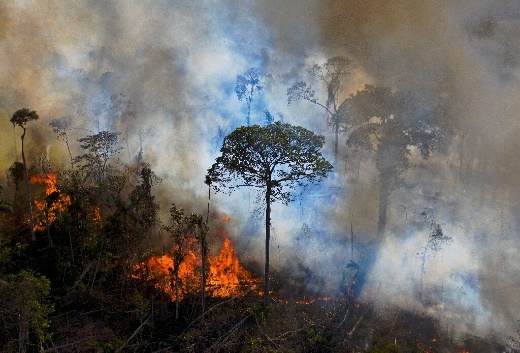
One of the ways to persuade countries to adopt sustainable practices is to refuse to buy products produced without consideration to sustainability. The EU plans to bar food and wood imports from deforested areas, according to a proposal unveiled Wednesday, aimed at using the EU’s trade power to drive sustainability. Under the EU plan, two criteria would have to be met: that the commodities are produced by the origin country’s laws, and that they were not produced on land deforested or degraded since the beginning of 2021. Imports from higher-risk countries would be subject to tighter checks. The rules could impact countries such as Brazil, where European disquiet at razing of the Amazon rainforest by cattle farmers is holding up implementation of an EU-Mercosur trade deal. The environmental protection group, WWF, says the huge EU market is responsible for 16% of global deforestation linked to international trade. Waste exports to non-OECD countries would be restricted and allowed only if those destinations agree and were able to handle them sustainably. Currently, the two top destinations for EU waste in that category are Turkey and India.
6. Researchers develop a global timber tree barcoding library

Illegal logging poses a major threat to biodiversity and ecosystem services, and it drives deforestation. Accurate identification of species from timber is an essential step to help control illegal logging and forest loss. DNA barcoding is regarded as a promising molecular tool for species identification, using short-length, standardized DNA fragments. However, there is still no reliable DNA reference database for timber species of economic and ecological importance.
Researchers led by Jie Li, Xishuangbanna Tropical Botanical Garden, Chinese Academy of Sciences, Kunming, China, have constructed a comprehensive barcode library, using four commonly used barcodes, representing 1,550 commercially traded timber species from China and internationally. The researchers assessed the efficiency of the four DNA barcode loci to help resolve the identity of threatened timber species from the Red List of Chinese Higher Plants. Overall, they found Internal transcribed spacer 2 (ITS2) is the best single marker for Chinese timber species, but it, along with Maturase K and trnH-psbA spacer, exhibited enhanced power of discrimination between closely related species in the dataset covering diverse internationally traded timber species.
Access the abstract at https://onlinelibrary.wiley.com/doi/10.1111/1755-0998.13546
7. Pesticides can harm bees twice—as larvae and adults

Honey bees have a reputation for working hard, but carpenter bees and other bee species that don’t live in colonies might be even more industrious. For these so-called solitary bees, there is no dedicated worker class to help with rearing the young and foraging. Many pesticides are known to harm bees; one is particularly dangerous. The neonicotinoids are systemic and permeate the tissue of plants, and they end up in pollen and nectar. These pesticides disrupt learning and memory in honey bees, and several studies have shown solitary bees suffer the same kind of damage. At higher levels, the chemicals interfere with reproduction, by reducing the viability of sperm. Bees that had consumed pesticides had 30% fewer offspring, compared with bees that had grown up without pesticides. Those insects with a double dose over the 2 years they had consumed pesticides, as larvae in the first year of the experiment and then again as adults when they collected pesticide-laden pollen from flowers, laid about 20% fewer eggs than did bees that had only been exposed as larvae.
For more, see https://www.science.org/content/article/pesticides-can-harm-bees-twice-larvae-and-adults?utm_campaign=news_daily_2021-11-22&et_rid=411559884&et_cid=4005622 and https://phys.org/news/2021-11-pesticide-fertility-blue-orchard-bee.html
Access the abstract at https://www.pnas.org/content/118/48/e2109909118
8. Addressing food insecurity and boosting the resilience of food systems in West Africa

About four million people in West Africa are expected to benefit from a new multi-phase regional programme that will complement and enhance ongoing efforts to reduce food insecurity and improve the resilience of food systems. The new Food Systems Resilience Program was approved by the World Bank’s Board of Executive Directors recently for $570 million in International Development Association financing. The first phase of the programme, amounting to $330 million, involves Burkina Faso, Mali, Niger, and Togo and three regional organizations, namely the Economic Community of West African States, the Permanent Interstate Committee for Drought Control in the Sahel, and the West and Central Africa Council for Agriculture Research and Development, to implement a broad programme that will focus on increasing agricultural productivity through climate-smart agriculture, promoting intraregional value chains and trade, and building regional capacity to manage agricultural risk.
For more, see https://indiaeducationdiary.in/addressing-food-insecurity-and-boosting-the-resilience-of-food-systems-in-west-africa/
9. Urbanization is not always bad for food and land use diversity
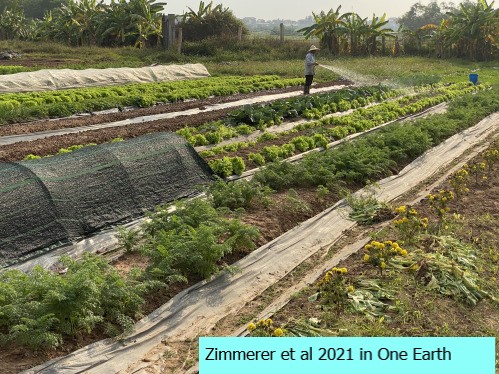
It is generally assumed that expanding urbanization affects food biodiversity and broader agrobiodiversity, which are essential nutrition and ecosystem resources for sustainable development but are threatened globally. However, some of the negative impacts could be possibly minimized, and new opportunities presented by urbanization could be used to promote agrobiodiversity.
Karl Zimmerer and colleagues at the Pennsylvania State University, USA, developed an interdisciplinary perspective to identify and understand the bidirectional interactions of agrobiodiversity in four major linkages: urban and peri-urban land use, urban food supply chains, urban food access, and urban food retailing. The framework looks at the intersection of urbanization and agrobiodiversity-biodiversity in food production and consumption, as well as agricultural ecosystems in four different areas: land use; supply chains; food access and foodways; and urban infrastructure and food retail. While less biodiverse food chains will still supply food to urban populations, they may not solve the problems of nutritional insecurity.
For more, see https://phys.org/news/2021-11-urbanization-bad-food-diversity.html
Access the abstract at https://www.cell.com/one-earth/fulltext/S2590-3322(21)00598-4
10. China’s crop germplasm resources census shows advantages, challenges for seed security
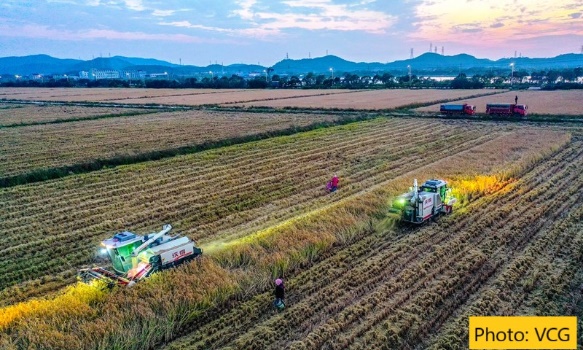
China’s Ministry of Agriculture and Rural Affairs recently announced the top seed resources detected in its largest-ever agricultural germplasm resources census, as the country strives to achieve self-sufficiency in breeding and seed production, which has been elevated to crucial status in its efforts in protecting national security. To achieve seed self-reliance, China began a three-year census, starting in March 2021, of the domestic crop, livestock, poultry, and aquatic germplasm resources. The construction of the national germplasm bank is an important pillar to ensure the long-term strategic conservation of the country’s crop genetic resources, and it is expected to play a major role in ensuring national food security and sustainable development. As China started relatively late in the plant breeding industry, it may take quite some time to catch up, says Wang Zuli at the Institute of Agricultural Economics and Development of the Chinese Academy of Agricultural Sciences, adding that efforts should be made on the technical level to lift the ability to identify the good genes from germplasm resources and enhance the protection of intellectual property rights in the seed industry to build world-class seed companies.
For more, see https://www.globaltimes.cn/page/202111/1239732.shtml
11. Climate-smart agriculture launched in South Asia
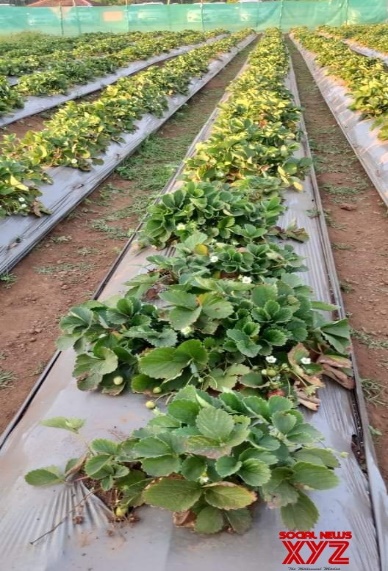
The International Fund for Agricultural Development (IFAD), SAARC Agriculture Centre (SAC), International Food Policy Research Institute (IFPRI), and SAARC Development Fund (SDF) have launched a partnership for scaling up climate-smart agriculture in South Asia. Together, they plan to develop evidence-based strategies to collectively tackle the impact of climate change in South Asia. The partnership will focus on promoting sustainable and resilient agricultural intensification in South Asia, through building the capacity of institutions and enhancing skills, to scale up climate-smart strategies and technologies. The SAARC Agricultural Centre will promote and support regional cooperation among the SAARC Member States in fostering sustainable and resilient agricultural adaptation in South Asia. To date, cross-border cooperation between national agricultural research and extension systems in South Asia has largely remained constrained, owing to lack of capacity, and the new effort is expected to correct this situation. The project will aim to benefit the smallholders, focusing on women farmers, as well as researchers, extension workers, and policymakers in SAARC member countries, with particular focus on Afghanistan, Bangladesh, Bhutan, India, Nepal, Pakistan, and Sri Lanka for piloting and scaling up of CSA technologies.
For more, see https://www.socialnews.xyz/2021/11/24/climate-smart-agriculture-launched-in-south-asia/
12. One billion more people could join the ranks of those already unable to afford a healthy diet

Approximately three billion people, almost 40% of the world’s population, cannot afford a healthy diet, and another one billion people could join their ranks should further unpredictable events reduce incomes by one-third, the FAO has said, in a new report released recently. The report defines shocks as short-term events that have negative effects on a system, people’s well-being, assets, livelihoods, safety, and ability to withstand future shocks. The report highlights the urgent need for countries to make their systems more resilient to sudden shocks, like the COVID-19 pandemic, which played a large part in the latest global hunger surge. While food production and supply chains have historically been vulnerable to climate extremes, armed conflicts, or increases in global food prices, the frequency and severity of these shocks are on the rise. Based on the evidence in the report, FAO makes a series of recommendations, including the urgent need for diversification—of actors, input sources, production, markets, and supply chains—to create multiple pathways for absorbing shocks, supporting the development of small and medium agrifood enterprises and cooperatives, well-connected networks (transport, marketing, inputs, and labour), and improving the resilience of vulnerable households.
Access the full report at https://www.fao.org/3/cb4476en/cb4476en.pdf
Events (June 2022)
1. 4th Global Summit on Food Science, Nutrition, and Technology. 09-10 Jun 2022, Singapore City, Singapore.

#For more, see https://foodsummit.foodtechconferences.org/
2. International Conference on Agroecology and Agricultural Production.

10-11 Jun 2022, Tokyo, Japan.
For more, see https://conferenceindex.org/event/international-conference-on-agroecology-and-agricultural-production-icaap-2022-june-tokyo-jp
3. International Conference on Agriculture and Horticulture. 14-15 Jun 2022, Montreal, Canada.

For more, see https://conferenceindex.org/event/international-conference-on-agriculture-and-horticulture-icah-2022-june-montreal-ca
4. 14th International Conference on Agriculture and Plant Science. 22-23 Jun 2022, Sydney, Australia.

For more, see https://agriculture.conferenceseries.com/
5. 2nd International Conference on Agroecology and Organic farming— Imaginative and Ecofriendly Approaches for Agroecology. 23-24 Jun 2022, Paris, France.

For more, see https://organicfarming.plantscienceconferences.com/
Other Topics of Interest
Glyphosate herbicide key driver of reduced carbon emissions in agriculture, academic study finds
SHIFT Prize: award for transformative agroecological research
For more, see https://www.agroecology-pool.org/news/shift-prize-award-for-transformative-agroecological-research/
Climate change and agriculture: What is the role of policy?
For more, see https://www.aei.org/research-products/report/climate-change-and-agriculture-what-is-the-role-of-policy/
Latin American rice breeding gets a boost from genomic tools
For more, see https://www.sciencedaily.com/releases/2021/11/211108161427.htm
Access the full paper at https://acsess.onlinelibrary.wiley.com/doi/10.1002/tpg2.20134
A farming reboot could lay seeds for prosperity in poor and food-insecure regions
For more, see https://www.sciencedaily.com/releases/2021/10/211027122117.htm
Access the abstract at https://www.nature.com/articles/s43016-021-00386-7
Study proposes a two-step plan to combat China’s waning agricultural exports
For more, see https://phys.org/news/2021-11-two-step-combat-china-waning-agricultural.html
Access the full paper at https://www.sciencedirect.com/science/article/pii/S2666660X21000323?via%3Dihub
Island conservationists identify key barriers to meeting biodiversity targets
For more, see https://phys.org/news/2021-11-island-conservationists-key-barriers-biodiversity.html
Access the full paper at https://conbio.onlinelibrary.wiley.com/doi/10.1111/csp2.587
Plant Ecology Herbivory and pathogen damage
Access the full paper at https://besjournals.onlinelibrary.wiley.com/doi/10.1111/1365-2745.13801
73 solutions to the climate and biodiversity crisis
For more, see https://horizon.scienceblog.com/1884/73-solutions-to-the-climate-and-biodiversity-crisis/
European collaboration on Plant Genetic Resources is missing opportunities
For more, see https://www.wur.nl/en/show/European-collaboration-on-Plant-Genetic-Resources-is-missing-opportunities.htm
Access the full paper at https://www.mdpi.com/2223-7747/10/10/2165
Woodland and hedgerow creation can play a crucial role in action to reverse declines in pollinators
Access the full paper at https://besjournals.onlinelibrary.wiley.com/doi/10.1111/1365-2664.14058
Urbanization affects how people perceive and benefit from ecosystem service bundles in coastal communities of the Global South
Access the full paper at https://www.tandfonline.com/doi/full/10.1080/26395916.2021.1890226
The study of the microbiome enables new strategies for healthy and climate-resilient crops
For more, see https://phys.org/news/2021-11-microbiome-enables-strategies-healthy-climate-resilient.html
Access the full paper at https://nph.onlinelibrary.wiley.com/doi/10.1111/nph.17820
